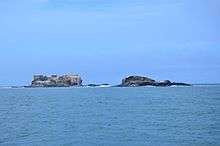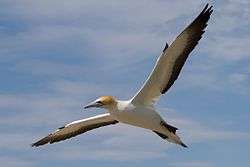Lawrence Rocks
|
The Lawrence Rocks are an important breeding site for Australasian gannets | |
 Lawrence Rocks | |
| Geography | |
|---|---|
| Location | Bass Strait |
| Coordinates | 38°24′30″S 141°40′10″E / 38.40833°S 141.66944°ECoordinates: 38°24′30″S 141°40′10″E / 38.40833°S 141.66944°E |
| Administration | |
|
Australia | |
| State | Victoria |
The Lawrence Rocks are a group of two rocky islets, 6.8 ha and 1.5 ha in area, with an associated reef, 2.4 km south-east of Point Danger in western Victoria, Australia, and about 6 km south-east of the city of Portland. Geologically, the group is formed from the remnants of an extinct volcano, with the islets composed of basalt and tuff.[1]
The islets were sighted by Lieutenant James Grant on 5 December 1800 from the survey brig HMS Lady Nelson and named[2] for Captain Effingham Lawrence,[3] one of the Elder Brethren of Trinity House.

Fauna
The rocks are protected as a nature reserve and are the site of a breeding colony of Australasian gannets, the overspill from which led to the establishment of a sister colony at Point Danger.[4] The group has been identified by BirdLife International as an Important Bird Area (IBA), because it supports over 10% of the world population of Australasian gannets, being used by over 6000 birds.[5] Other birds recorded on the rocks, and likely to breed there, include little penguins, black-faced cormorants, crested terns, silver gulls, sooty oystercatchers and small numbers of Cape gannets. The rocks are also used as a haul-out site by Australian fur seals.[1]

References
- 1 2 BirdLife International. (2011). Important Bird Areas factsheet: Lawrence Rocks. Downloaded from http://www.birdlife.org on 04/08/2011.
- ↑ Grant, James (1803). The narrative of a voyage of discovery, performed in His Majesty's vessel the Lady Nelson, of sixty tons burthen: with sliding keels, in the years 1800, 1801, and 1802, to New South Wales. Printed by C. Roworth for T. Egerton. pp. 71–72. ISBN 978-0-7243-0036-5. Retrieved 25 January 2012.
- ↑ Wall, Bruce (1967). "Lawrence, William Effingham (1781–1841)". Australian Dictionary of Biography. Canberra: Australian National University. Retrieved 25 January 2012.
- ↑ "Point Danger Australasian Gannet Breeding Colony". Portland Holidays. Archived from the original on 2006-08-19. Retrieved 2011-02-28.
- ↑ "IBA: Lawrence Rocks". Birdata. Birds Australia. Retrieved 2011-08-04.
